Posted: October 9, 2013 | Author: seannygorman | Filed under: JOUR206 | Tags: audience, citizen journalism, convergence, convergent media, journalism, kate mcclymont, legacy media, media, online, platform, platforms, professional journalism, social networking, social-media, traditional, tweets, twitter, twitterisation, user empowerment |
Twitter’s Impact on Professional Journalism
The future of professional journalism has been questioned in recent years, due to the increasing popularity of social networking sites like Twitter that make reporting and sharing news a faster and more efficient way of communication. There is no doubt that Twitter is having a transformative effect on professional journalists and journalism, as the circulation of print news, for example, and the profits drawn from this are decreasing each year, yet journalists on Twitter have had their ‘followers’ increase exponentially (Ahmad 2010, pp. 146). It must, however, be asked whether this effect is positive or negative and whether or not Twitter and similar online journalistic practices will replace traditional journalism in the future. In this essay, the transformative effect Twitter is having on professional journalism will be discussed and specific examples will be drawn from to determine how much of an impact Twitter has on the breaking news cycle, the engagement with audiences, the convergence of a journalist’s professional and private lives as well as the processes of verifying news that is being communicated. While various perspectives will be discussed, this essay aims to show that traditional journalism and Twitter should be considered as equal partners in news reporting, benefiting from one another, especially in terms of the reporting of breaking news. The transformative effect that Twitter has on professional journalism may have negative impacts in many ways, yet a convergence of both traditional and Twitter reporting styles can create a collaboration of stories that can be brought together to create a complete and transparent “final product” (Barnes 2012, pp. 24).
Case Study: Kate McClymont
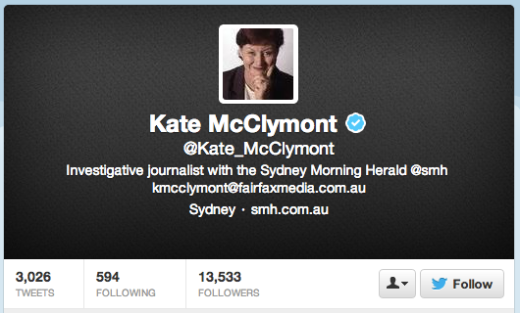
Journalist Kate McClymont’s tweets were chosen as the case study for this essay. Her twitter profile was monitored over the period of seven days, where 56 tweets were captured from the 27th of September at 9.38am to the 3rd of October 6.40pm. Kate McClymont is an investigative journalist with the Sydney Morning Herald, recently awarded as Fairfax Woman of Influence for 2013 (Grubb 2013). McClymont’s reputation provides us with a journalist who is well known for her success in traditional journalism practices.
The data was collected over the seven day period by noting down what had been tweeted at the end of each day. The data that was analysed from McClymont’s tweets was that of the frequency and content of posting, the content, the ratio between retweets and original tweets, the ratio between journalistic tweets and personal tweets, the frequency and content of @replies and the content accessed through tweeted links. These aspects of McClymont’s twitter profile were analysed in order to be useful in showing examples of breaking news, audience engagement, personal and professional boundaries and verification processes. Kate McClymont’s tweets also serve as an excellent example of how Twitter has had a transformative effect on professional journalists as her profile provides us with examples of both the positive and negative impact of Twitter.
What others are saying
There has been copious literature written about Twitter used in journalistic practices in the last three years. The basis for the chosen literature was around the examples provided for journalistic practices on social media, specifically that of the breaking news cycle and its different forms in traditional news outlets and online news outlets.
Ahmad (2010), Bruns (2012) and Johsnon (2012) take an empirical approach in their articles. While discussion over positives and negatives are evident, these authors are far more confident in Twitter in enhancing journalism than other studied authors, stating that 2010 was “a journalistic year that belonged to Twitter” (Ahmad 2010, pp. 146). Ahmad uses The Guardian as a case study, following the UK newspaper’s transformation to online, where Twitter became a key factor in reporting on breaking news and how not only professional journalists can report quickly on it but also witnesses to events are able to post their own content (2010, pp. 148). Bruns uses his own research into the 2010 Australian Labor Party’s spill and its coverage on Twitter through the #spill hashtag. He analyses the number of visible tweets using the hashtag and the people they have come from, which draws out very interesting results in terms of the journalist having their own Twitter profile for both personal and professional use. Johnson furthers the concept of the ‘citizen journalist’ through talking about how people are given a voice they never had before (2012, pp. 17).
On the other hand, Murthy’s (2011), Barnes (2012) and Lasorsa’s (et al. 2011) articles on Twitter approach the concept in a more theoretical matter. While they draw on historical examples of both traditional journalism and more recent Twitter practices, the discussion is based more on the theory of how Twitter can be seen to be transforming professional journalism and where this could possibly lead. Murthy (2011) does not discount Twitter, yet believes that the platform, where “short messages are often trivially banal” (pp.780) would “not displace the usefulness of traditional news media” (pp. 784). Barnes (2011) too states that “only a trained journalist understands the level of fact-checking that is required”. These two authors concern themselves with the implications involved in verification and reliability in microblogging. They could only go so far as to imagine Twitter working alongside professional journalism to some degree, rather than enhancing it, or replacing it. Additionally, Lasorsa et al. raises questions over the fine line between conveying opinion and conveying information in tweets (pp. 24).
Twitter revolutionising the Breaking News Cycle
Twitter is having an enormously transformative effect on professional journalism and this is specifically due to the ability for breaking news to be posted and communicated within a matter of seconds as news happens. The power of Twitter for breaking news was first realised during the Mumbai Massacre in 2008 and since this point, many professional journalists have created Twitter accounts in a response to the importance of social media (Posetti 2009). Ingram (2012) believes that not only is it fundamental that news is communicated immediately as it occurs, but also sees a positive in it being able to defuse incorrect reporting in a hastier fashion than it could be through traditional news outlets. Kate McClymont’s twitter feed proved efficient in breaking news, with the first set of tweets analysed being that of a live-tweeted court case. In short and clear sentences, McClymont was able to report as the court case was happening:
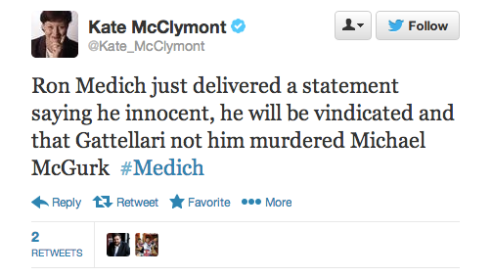
(McClymont, 2013)
The addition of the #Medich hashtag also remained consistent through the next 4 tweets she had about the court case and others who replied to her also used this hashtag.
Another aspect of Twitter which is employed by many journalists in breaking news is that of sharing media such as photos, video or audio, or posting links to other online content (Posetti, 2009). While McClymont has not posted photos or audio, she did tweet the link to her official and traditional article on the court case. The fact that the news story was published the following day, however, shows how traditional journalism is slower in reporting news. As mentioned, the one-day story has now become the one-hour story (Ingram, 2012). On the other hand, a traditional news article can encompass the story in a complete and final product (Barnes 2012, pp. 24) in a way that Twitter cannot do in 140 character or less. Nevertheless, tweets and news article can work together. As Murthy (2011) states, Twitter can “represent a new means for traditional media to pick up a scoop” which he deems necessary as traditional media needs to exist in order to “cover in-depth or longer-running issues” (pp. 784).
Additionally, McClymont uses retweets to report breaking news, such as this retweet from the NSW Rural Fire Service (via McClymont 2013) that warns of the Barrenjoey Headland fire and reports of what has happened so far. However, McClymont’s use of retweeting overall is ineffective for the breaking news cycle as she usually retweets replies made to her which are people expressing their opinions on long-going news items, rather than that of breaking news. When live-tweeting is employed in McClymont’s microblogging on Twitter, it is extremely effective and gains significant response, however the consistency is not present. Of the seven days of tweets analysed, this was the only day she did live-tweeting, and notably her tweet count for the day is significantly higher than any other day where she was not posting live news. A live-tweeted event she was in attendance at in addition to a traditional article, creates a complete story. The transformative effect Twitter is having here is quite a positive one as that the news story has been encompassed by both professional journalism and Twitter itself.
The rapid increase in social networking journos
Audience engagement of print news has seen to rapidly decline yet journalists who have embraced Twitter are gaining more followers than they ever had on traditional news media (Ahmad 2010, pp. 146). In terms of audience engagement, Twitter allows for an increased amount of conversation to occur, and give people “who would once have been powerless, a voice” (Johnson 2012, pp. 17). While blogging has existed for a longer period of time, microblogging has developed what is information designed for viral communication (Lasorsa et al. 2011, pp. 20). However, the convergence of professional and private lives is a line easily faltered. Kate McClymont’s tweeting over the seven day period studied was mostly professional, if not sometimes tweeting an opinion on a news story: “Got to feel for Bunnies’ coach Michael Maguire – losing his mother and the match is heartbreaking” (McClymont 2013). There is a difficulty in determining what is appropriate for a professional journalist to tweet as a tweet can be judged as primarily conveying opinion or primarily conveying information (Lasorsa et al. 2011, pp. 26). The aforementioned tweet does convey information more so, with a personal opinion integrated and McClymont was effective in her communications for the most part of the seven day study. However, on the 2nd of October, McClymont retweeted a large amount of replies to a personal tweet about running for Senate at the University of Sydney. She retweeted replies such as:
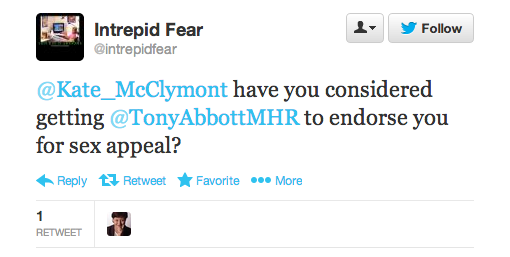
(Intrepid Fear 2013)
While this may be a reply to a personal tweet, it is still politically-minded and makes a joke based on the recent Australian elections. It is difficult to determine how far a professional journalist can cross the line and in comparison to the other days’ tweets, this was a day of overly-tweeting and retweeting personal content.
In addition, according to research completed by Lasorsa et al. (2011), 19.1 percent of the journalists’ tweets they studied were promotional, as can be seen in McClymont’s (2013) own tweets:
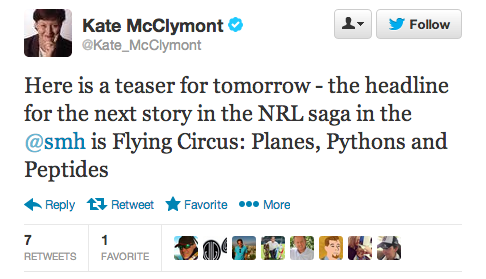
(McClymont 2013)
This strategy is effective in promoting her actual career and the writing she does for the Sydney Morning Herald. Therefore Twitter and professional journalism can be seen to once more converging to create something that allows full coverage of the news to be experienced. Twitter is transforming traditional articles into a final article that can be read as normal, but with a way of creating conversation about it through McClymont’s twitter feed. Therefore audience engagement is very effective when old and new media converge.
But can Twitter news be trusted?
While the “real-time nature of the political cycle now means that stories can emerge and get circulated almost everywhere at lightning speed” (Ingram 2012), this ‘lightning speed’ does not allow pause for verification on how reliable news sources onTwitter are. It can be argued that only a trained journalist can be relied upon for accuracy and objectivity (Barnes 2012, pp. 19). The biased nature of the blogger challenges nonpartisan gatekeeping of information, that is journalism’s main identity and purpose (Lasorsa et al. 2011, pp. 21). Barnes (2012) believes that while the content shared online by citizen journalists can be valuable, it is only when traditional journalists use the content it is can be considered reliable. It is this concept of traditional journalists using content from Twitter which creates a convergence of traditional and new journalistic styles where “they shape the final product” (pp. 24).
However, the amount of content that can be read online about one news story allows for a number of perspectives to be seen and for Twitter uses to determine the truth by analyzing all the content on offer. Additional information can also be gained about news stories that would not be found in a finalised, traditional news report. For example, Kate McClymont posted a link to an article she had written about a woman who chose euthanasia to end her own suffering. A follower asked McClymont a question on this and she was able to reply and give further light on the article:
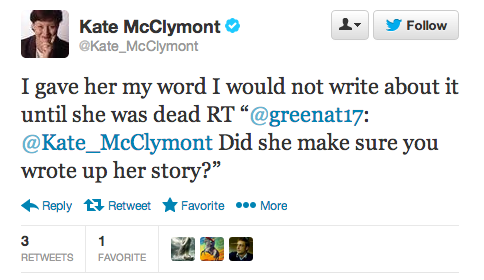
(McClymont 2013)
With a combination of tweets and traditional reporting, Kate McClymont is a prime example of how verified and accurate information can be presented. Johnson (2012) believes that while Twitter may create accurate and informative news content, it “gets traction only when the mainstream media take up the cause” (pp. 17). While she is a professional journalist on Twitter and not a citizen journalist, if she were to further her Twitter usage so that she could interact with her followers more on the news content they post, then she could ensure that citizen journalism could be verified through her own tweets and a grand scale of news content could be encompassed, as she has shown in her tweets already.
Conclusions drawn
Twitter is definitely having a transformative effect on professional journalism and, for the most part, can be considered a positive one, contributing to the communication of news rather than hindering traditional media outlets in terms of their communicating of news. In terms of breaking news, we can see that Twitter is being effective in reporting news quicker than traditional reports, yet traditional reports are still beneficial in gaining a complete overview of the news the following day. The audience interaction with this can also be seen as Twitter can be used as a device to create conversation about the traditional article, however the private lives of journalists can sometimes interfere with the professionalism of their profile. Furthermore, while professional journalists can be relied upon for accuracy, the quantity of content on Twitter allows for users to determine truths for themselves, however old and new media can work together in creating objective reporting. The combination of traditional journalism and new media journalism creates a new and exciting development in the reporting of news that is incredibly transformative and, most importantly, transforming in the right ways.
written by Sean O’Gorman for UOW’s JOUR206 class on Convergent Journalism.
REFERENCES
Ahmad, A 2010, ‘Is Twitter a useful tool for journalists?’, Journal of Media Practice, vol. 11, no. 2, pp. 145-155.
Barnes, C 2012, ‘Citizen Journalism vs. Traditional Journalism: A Case for Collaboration’, Caribbean Quarterly, vol. 58, no. 2, pp. 16-27, 179.
Bruns, A 2012, ‘Journalists and Twitter: how Australian news organisations adapt to a new medium’, Media International Australia incorporating Culture and Policy, no. 144, pp. 97-107.
Grubb, B 2013, ‘Kate McClymont recognised as Fairfax Media’s Woman of Influence’, Sydney Morning Herald, 3 October, viewed 3 October 2013, <http://www.smh.com.au/national/kate-mcclymont-recognised-as-fairfax-medias-woman-of-influence-20131003-2ux4c.html>
Ingram, M 2012, Is Twitter Good or Bad for Political Journalism, Bloomberg Business Week, weblog post, 28 August, viewed 4 October 2013, <http://www.businessweek.com/articles/2012-08-28/is-twitter-good-or-bad-for-political-journalism>
Intrepid Fear 2013, ‘@Kate_McClymont have you considered getting @TonyAbbottMHR to endorse…’ via Kate_McClymont, Twitter, 2 October, viewed 3 October 2013, <https://twitter.com/intrepidfear/status/385190709130584064>
Johnson, J 2012, ‘The Power of Twitter’, British Journalism Review, vol. 23, no. 15, pp. 15-17.
Lasorsa D, Lewis S & Holton A 2012, ‘NORMALIZING TWITTER’, Journalism Studies, vol. 13, no. 1, pp. 19-36.
MacMillan, G 2013, Guardian says Twitter surpassing other social media for breaking news traffic, The Twitter Blog Network, weblog post, 29 July, viewed 3 October, <https://blog.twitter.com/2013/guardian-says-twitter-surpassing-other-social-media-for-breaking-news-traffic>
McClymont, K 2013, ‘Ron Medich just delivered a statement saying…’, Kate_McClymont, Twitter, 27 September, viewed 28 September 2013, <https://twitter.com/Kate_McClymont/status/383383241664630784>
McClymont, K 2013, ‘Here is a teaser for tomorrow…’, Kate_McClymont, Twitter, 27 September, viewed 28 September 2013, <https://twitter.com/Kate_McClymont/status/383546909320699904>
McClymont, K 2013, ‘Got to feel for Bunnies’ coach Michael Maguire…’, Kate_McClymont, Twitter, 27 September, viewed 28 September 2013, <https://twitter.com/Kate_McClymont/status/383562419890421760>
McClymont, K 2013, ‘I gave her my word I would not write about it until she…’, Kate_McClymont, Twitter, 28 September, viewed 28 September 2013, <https://twitter.com/Kate_McClymont/status/383815806431150080>
Murthy, D 2011, ‘Twitter: Microphone for the masses?’, Media, Culture & Society, vol. 33, no. 779, pp. 779-789.
NSW Rural Fire Service 2013, ‘Barrenjoey Headland fire now Watch and Act…’, via Kate_McClymont, Twitter, 28 September, viewed 28 September 2013, <https://twitter.com/NSWRFS/status/383837790531620864>
Posetti J 2009, How Journalists Are Using Twitter in Australia, Media Shift PBS, weblog post, 27 May, viewed 2 October 2013, <http://www.pbs.org/mediashift/2009/05/how-journalists-are-using-twitter-in-australia147/>
Posetti J 2009, How Journalists Balance Work, Personal Lives on Twitter, Media Shift PBS, weblog post, 8 June viewed 2 October 2013, <http://www.pbs.org/mediashift/2009/06/how-journalists-balance-work-personal-lives-on-twitter159/>
Posted: September 1, 2013 | Author: seannygorman | Filed under: JOUR206 | Tags: audio interview, emotional history, emotions, emotive, human emotions, interview, mental health, reflection, reflective |
My experience of undertaking the Emotional History assignment was one of only few difficulties and was completed mostly with ease. However, it taught me that preparation is key. It taught me that audio interviewing for emotional impact is a difficult task, as you are constantly aware that you need to capture the emotions that the interviewee was feeling whilst recounting their story and in order to do so need to ask probing questions, but at the same time need to keep a distance as to not offend or upset the interviewee.
With my assignment, I interviewed my friend Lyndsay, so this cautious approach to interviewing was less of worry as we are close friends. It is comparatively easier for a friend to open up to me than a complete stranger to open up to me.
The only risk I did encounter with this assignment was the fear that I would not be able to get Lyndsay to remain fine with being interviewed. Lyndsay had offered to tell me his story but I was worried that he may back out because of how sensitive his story is. I overcame this risk by confirming with him many times that he was okay with being interviewed, even informing him that it would be posted online on Soundcloud and WordPress. He remained fine with this and so the interview was carried out.
A pitfall I encountered on this assignment was the flu. Being very sick for the last week, I had not had enough time to prepare for the interview, having written out my questions on the day. On the day of the interview, I was feeling so sick that I hadn’t checked the audio levels on the mic, hadn’t ensured the area we were doing the interview was quite enough and other such factors that need to be considered. My mind was unable to be completely on the job, and I’m lucky that the audio levels were good and that the responses I got from the interview were great that I didn’t have to redo any parts.
The flu also became quite a risk as well, as if Lyndsay did drop out of the interview then I would have had to find another subject to interview which I fear would not have even happened with how sick I have been.
From this Emotional History assignment, I learnt that discussing the story with the interviewee beforehand was quite effective. While not going into great detail, as that would have detracted from the emotive responses I recorded, general conversation over the story left Lyndsay feeling more comfortable about discussing his story as he had already overcome revealing it to me.
I also learnt that silence is just as good as having sound effects and music. While playing around with various ideas for the final edit, I realised that the silence of the interview was more effective in creating the mood I required for the story, than having sound effects to reflect mental illness. Having the sounds of the Duck Pond lawn at the beginning and end of the piece left the interview feeling melancholy, which I found perfect.
If I were to do this assignment again, I would probably approach it in a more prepared manner. While the flu was a significant reason why I was unable to, I would give myself more time to look into other subjects I could interview. I think I need to explore other people more and interview someone I don’t know personally so that I can properly practice interviewing, however Lyndsay’s story was just so emotive that I couldn’t possibly leave it alone.
I would also allow myself more time to test the sound more efficiently and probably find more questions to ask as the interview only went for 20 minutes, whereas I could have had a longer interview that would have given me more content.
Overall, I find the Emotional History assignment a very useful way to work on my interviewing skills and also teaching me how to ask big questions on a sensitive topic without causing offense, yet gaining the emotional response I wanted.





